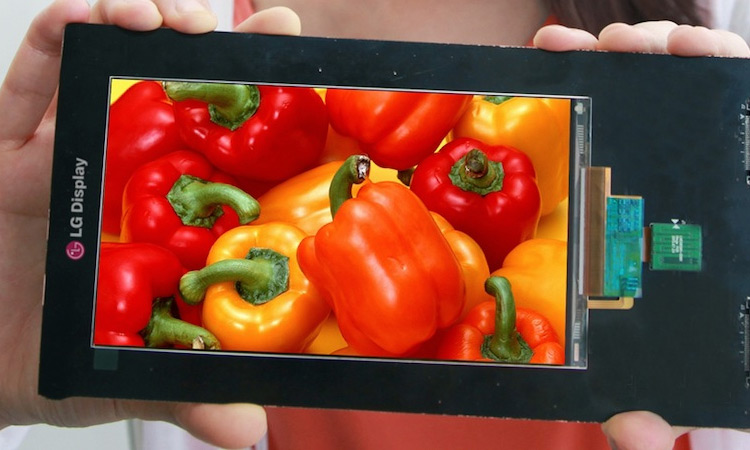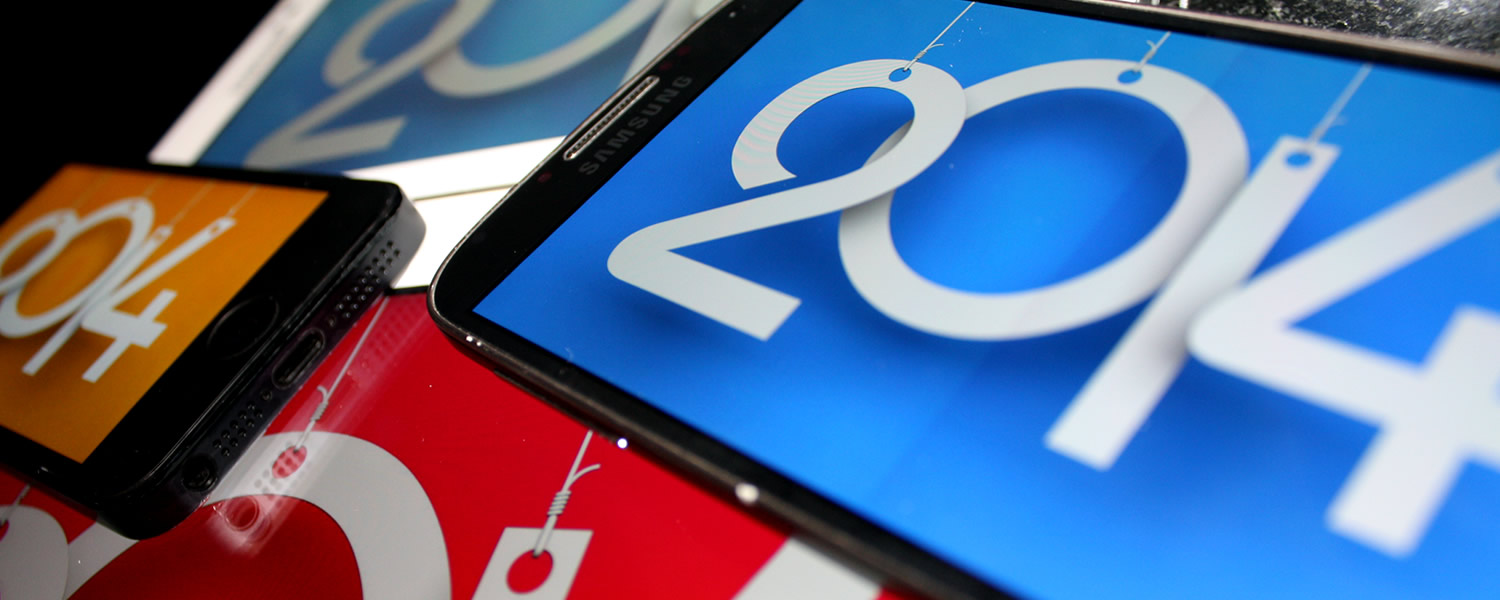In the past 12 months we were introduced to a range of cool new tech in the mobile space. High resolution 1080p displays made us question whether the smartphone you were holding was sharper looking than real paper, quad-core processors dominated every device from the top-end to the entry-level, and some smartphone cameras packed more megapixels than a professional DSLR. So what will 2014 bring? Here's our list of predictions for the next year in smartphone and tablet technology...
Curved Displays
Towards the end of 2013 we got a glimpse of what might be the future in Samsung's Galaxy Round and LG's G Flex. Both smartphones come with large curved OLED displays - the Round's is horizontally curved; the Flex is vertically - as each company trials a new form factor in their home nation of Korea. Expect that to change in 2014 though, as Samsung, LG and others push curved-screen handsets in Western nations as well.
It's unclear what the advantage is to having a curved display rather than a standard flat display, although it might have something to do with attempting to ergonomically fit your face during phone calls. What it does bring, though, is the goal of a flexible smartphone one step closer to reality, which has remained a pipe dream for many companies producing handsets today. A curved handset may not be the ideal form factor for the majority of users, so don't expect your favorite flagships to change that much, but curved displays will be available for those wanting something different.

A Slow Shift to 64-Bit
This is a trend that started with Apple and the release of the iPhone 5s. The custom-made Apple A7 SoC, used in the iPhone 5s, iPad mini and iPad Air, was the first ARM chip to ship in a consumer device with 64-bit addressing. Upon its release, companies such as Qualcomm and Samsung quickly sprang into action, announcing their next SoCs would be 64-bit capable and based on the ARMv8-A architecture.
In fact, Qualcomm announced their first 64-bit SoC in December 2013: the Snapdragon 410. It's not a high-end chip, rather a mid-range SoC that uses ARM's 64-bit-enabled Cortex-A53 CPU cores instead of the usual custom-made Qualcomm cores. Cortex-A53 is the successor to Cortex-A7, meaning it won't be as powerful as the A15 cores or other high-end ARM CPU cores, but nevertheless it will power Qualcomm's first 64-bit SoC scheduled for release in smartphones in the second half of 2014.
As for other chipmakers, it's been rumored that Samsung will bring a 64-bit Exynos chip to the next flagship Galaxy device; while Nvidia's first 64-bit chip, Tegra 6 will likely be seen in 2015 rather than 2014. We've seen the 64-bit architecture in the A7 deliver some speed benefits over 32-bit already, and being able to use more than 4 GB of RAM will also be beneficial to tablets and other multitasking-heavy devices. Considering that Android doesn't currently use 64-bit addressing in almost all of its libraries, we expect the transition to be slow, but interesting nonetheless.

Catching the Lumia 1020
Mid 2013 brought one of Nokia's greatest engineering achievements to date, with the Finnish company managing to stuff a 41-megapixel 1/1.5" sensor into the reasonably-sized Lumia 1020's smartphone body. Several months later they followed it up with a 20-megapixel sensor in the Lumia 1520, which only Sony managed to match in the Xperia Z1.
It seems the megapixel race is back on with 2014's big smartphone players likely to chase down Nokia's megapixel mark in their own range of camera-focused devices. With a 40+ megapixel sensor, there's little need for a bulky zoom lens like the Galaxy S4 Zoom had; instead it's possible to have both a slim, portable phone and a camera with 3x lossless zoom whose quality easily rivals standalone point-and-shoots. Say goodbye to the days of carrying a separate phone and camera to achieve good quality photos.
Not all of 2014's phones will come with huge megapixel counts like the Lumia 1020's though. Expect successors to the Galaxy S4, HTC One, LG G2 and other flagship handsets to come with more pixels, somewhere around the 20-megapixel range. Optical image stabilization should be a standard inclusion in 2014 to enhance low-light photography, and we wouldn't blame HTC if they ditched the largely unsuccessful 'UltraPixel' (4-megapixel) camera setup, which saw great low-light results at the expense of a good all-round shooter.
Displays Beyond 1080p
We're hesitant to say that including a display on a phone with a resolution beyond 1080p won't provide any benefits, after many people said the same going from 720p to 1080p. But out of everything on this list, progressing above 1920x1080 looks to have the fewest benefits beyond the specification sheet, especially as 1080p displays already look like paper. Despite this fact, Samsung, LG and others are pushing ahead with 2560x1440 smartphone displays and in 2014 we're likely to see a range of handsets that feature them.
1440p panels include 75% more pixels than their 1080p counterparts, meaning batteries will get consumed faster, and more graphics power will be needed to render your favorite games with the visual benefits remaining unknown.
Where we will see benefits are tablets, as manufacturers continue to strive for comparable pixel densities on large-screened devices. In 2014 it seems like we'll be blessed with 1080p/WUXGA panels on nearly all 7- and 8-inch devices, even low-cost ones following the 2013 Nexus 7's lead, and at least 1440p/WQXGA displays on 10-inch devices. Get prepared for a range of tablets that are even better for reading and viewing images in 2014.

Even Less Interest in Windows RT
Windows RT is Microsoft's unloved, unwanted operating system for ARM-based devices. As it turns out, consumers just don't want a Windows device that can only run apps from the meager selection in the Windows Store, preferring to purchase x86 tablets running full-blown Windows 8.1. It doesn't help that only two devices running Windows RT were released in 2013 - the Microsoft Surface 2 and Nokia Lumia 2520 - restricting consumer choice considerably.
It doesn't seem like 2014 will be a more prosperous year for Windows RT. Until Microsoft merges Windows RT with Windows Phone in 'Threshold' (likely to be released in 2015), expect no companies outside Microsoft to produce Windows RT machines. At the same time, fierce competition from Intel, and to a lesser extent AMD, will see a new range of x86 Windows tablets in 2014 with serious grunt and lengthy battery life, whether they're powered by Bay Trail, fanless Haswell, or Mullins. Where's the room for Windows RT when x86 platforms can do everything and then some?
LTE Everywhere
If you've been in the cycle of purchasing high-end smartphones for a while now, this development won't be all that useful to you. Flagship phones running all major OSes have come with 4G LTE radios for a while now, allowing download and upload speeds of up to 150 Mbps and 50 Mbps respectively in Category 4 devices. However those who tend to purchase budget oriented handsets, such as the Moto G, have been left out of the LTE party as SoC manufacturers cut costs by sticking to HSPA+.
Not in 2014 though, as there will finally be an emphasis on getting LTE to all users, coinciding with more widespread availability of the fast networks across many countries worldwide. China's TD-LTE launch in the last months of 2013 will be especially helpful in getting more LTE devices to the market as the competitive swathe of local OEMs push for low-cost 4G-ready devices. Expect the vast majority of 2014's smartphones, from the expensive to inexpensive, to be LTE ready.

Console Graphics Power
The graphics chips inside many smartphone and tablet SoCs are already quite powerful, but the next generation scheduled for release in 2014 will take things to the next level. Qualcomm's Adreno 420 and ARM's Mali-T7 series are interesting and powerful GPU developments, but not quite as exciting as the GPU Nvidia is integrating into their next-gen Tegra SoCs, codenamed 'Logan', that's scheduled for release in 2014.
Logan will come with a mobile Kepler GPU, featuring the same architecture as Nvidia's current range of desktop graphics cards. The company claims a full-power (2-3W) iteration of their SoC will deliver around 400 GFLOPS of performance, outdoing Sony's PlayStation 3, with full OpenGL 4.4, DirectX 11 and CUDA 5.0 GPGPU support. Demos of Logan have already been very impressive, showing off tessellation and advanced lighting on development boards.
It's up to game developers to produce AAA titles that can use the powerful GPUs set to come in tablets especially, but mobile gaming is becoming an increasingly lucrative market attracting the eyes of many top-tier developers. Soon we'll be blessed with many console-quality titles on mobile platforms, thanks in part to the power provided by next-gen mobile GPUs.

Cheaper Is Better
Several devices generated a lot of buzz in 2013 for packing decent hardware at a low price. The Nexus 5 was fast and came with a fantastic display for just $350, the Nexus 7 once again proved that a 7-inch tablet could be done right on the cheap, and the Moto G captivated the entry-level/mid-range. Let's not forget the Windows Phone camp either, where Nokia's Lumia 520 was one of the bestselling devices of the year.
Google's camp will continue to push out cheap Nexus devices, but it seems that 2014 might see other players join in on the expanding off-contract phone market. The sub-$200 price bracket is especially attractive, and with developments in low-cost SoCs (Snapdragon 410), low-RAM Android 4.4 and ever-optimized Windows Phone, it's possible for more OEMs to jump on the bandwagon. And of course, cheaper, better phones means more people can enjoy the best a smartphone has to offer.
No New Battery Technology
Unfortunately, major advancements in battery technology aren't going to be ready in 2014, so we'll have to rely on lithium-ion cells for a little while longer. Focus will remain on battery optimization and capacity, especially at the software level where savings can still be made, to increase the life of our handsets. Too many times did we see a device in 2013 with less than all-day stamina, and hopefully that will change come the next wave.
In the future we can look forward to lithium-air batteries, which promise 5-15 times the density of lithium-ion. Lithium-sulfur is another low-cost, high-density potential successor which may come to market in the next few years, while other teams are researching sodium-ion batteries. When these technologies eventually come to play we'll be able to make our devices much more powerful, or last far longer, but it's not going to happen in 2014.

More Operating Systems
Android captured a majority slice of the mobile OS pie a while ago, nonetheless a trend that's likely to continue in 2014 is the launch of more operating systems promising to do something different, or promising to reinvent the way we use mobile devices. Many of them will likely be Linux variants targeting low-end handsets, which is a space yet to be fully exploited.
Like with Firefox OS, BlackBerry 10, Sailfish OS, Ubuntu Touch, Tizen and many others we heard about in 2013, newcomers to the mobile OS race are probably not going to be too successful; Android, iOS and Windows Phone will remain the big players for some time to come. However, they will bring some innovative thinking to the table and give adventurous consumers a choice that isn't Android, which can only be good for competition and the industry as a whole.
